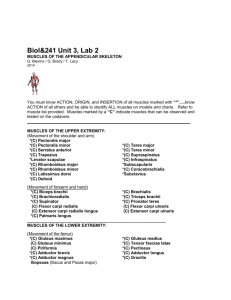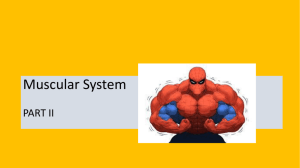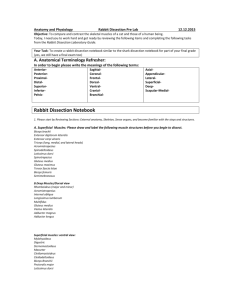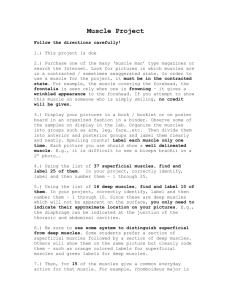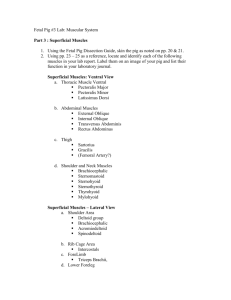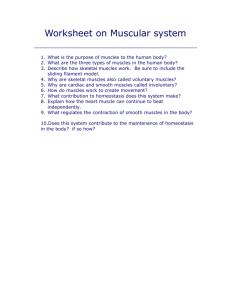Muscle Notes Part II
advertisement
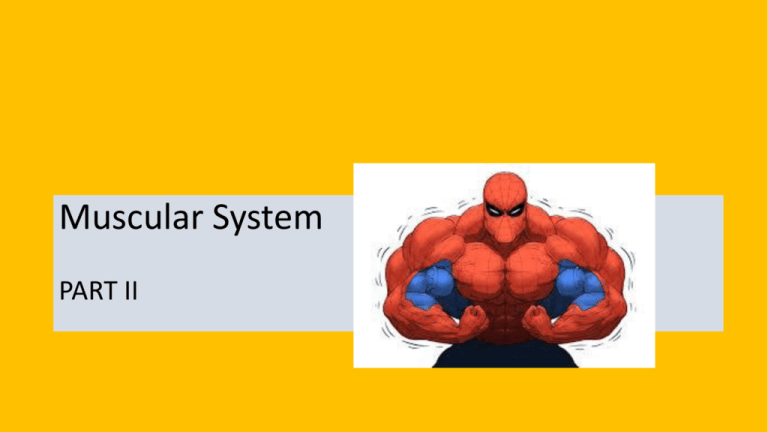
Muscular System PART II Muscular System PART II OBJECTIVES Muscle Movements, Types and Names (pp. 198 – 206) • Define prime mover, antagonist, synergist, and fixator as they relate to muscles. • Identify these types of body movements (from images): flexion/extension, supination/pronation, adduction/abduction, and inversion/eversion • List some criteria used in naming muscles. Gross Anatomy of Skeletal Muscle (pp. 206 – 219) • Name and locate the major muscles of the human body. Developmental Aspects (p. 221) • Explain the importance of a nerve supply and exercise in keeping muscles healthy. • Describe the changes that occur in aging muscles. Systems in Sync (p. 222) • Describe the homeostatic relationship between the muscular system and any one other system. Anterior and Posterior Diagrams *See Text p. 216 and 218 What’s in a name? MUSCLES ARE NAMED ACCORDING TO: 1. Muscle size - Examples: Gluteus maximus vs. Gluteus medius (Incidentally, there is also a Gluteus minimus…) 2. Muscle shape – Examples: Trapezius, Orbicularis and Rhomboideus 3. Associated bones – Examples: Zygomaticus and Flexor carpi ulnaris 4. Number and location of origins – Example: Biceps femoris 5. Action of the muscle – Example: Masseter and Flexor carpi ulnaris Major Muscles of the Face and Neck A. Frontalis F. Temporalis G. Obicularis oculi B. Occipitalis C. Masseter D. Sternocleidomastoid H. Zygomaticus I. Obicularis oris J. Buccinator K. Platysma A Human Body Dissected Major Muscles of the Anterior Trunk A. Sternocleidomastoid H. Zygomaticus B. Pectoralis minor I. Deltoid J. Pectoralis major C. Intercostals D. Serratus anterior E. Rectus abdominus F. Internal oblique G. Transversus abdominus K. External oblique Major Muscles of the Posterior Trunk D. Levator scapulae A. Trapezius B. Deltoid C. Latissimus dorsi F. Infraspinatus H. Teres major I. Rhomboideus Two areas used for intramuscular injections • Deltoid • Gluteus medius Major Muscles of the Lower Arm (Pronated – radius rotated over ulna) A. Triceps brachii D. Extensor carpi radialis B. Flexor carpi ulnaris (C. and E.) Extensors Major Muscles of the Lower Arm (Supinated – radius and ulna are parallel) A. Biceps brachii D. Brachioradialis E. Flexor carpi radialis F.-G. various flexors *Define prime mover, antagonist, synergist, and fixator as they relate to muscles. A prime mover is the muscle that has the major responsibility for causing a movement. Synergists – reinforce the same movement as the prime mover. If it stabilizes the Antagonists – oppose or reverse a movement. movement it may be called a fixator. Major Muscles of the Anterior Upper Leg B. Sartorius E. Adductors C. Rectus femoris D. Vastus lateralis F. Gracilis G. Vastus medialis Major Muscles of the Posterior Upper Leg A. Gluteus medius D. Gracilis E-F. Semitendinosus* G. Gastrocnemius B. Gluteus maximus C. Iliotibial tract H. Biceps femoris* *E. F. and H. are commonly known as the Hamstrings. Major Muscles of the Lateral Upper Leg A. Gluteus medius B. Gluteus maximus C. Biceps femoris E. Sartorius F. Rectus femoris G. Vastus lateralis Major Muscles of the Lateral Lower Leg A. Biceps femoris B. Vastus lateralis C. Gastrocnemius D. Soleus E. Tibialis Muscle Movements

